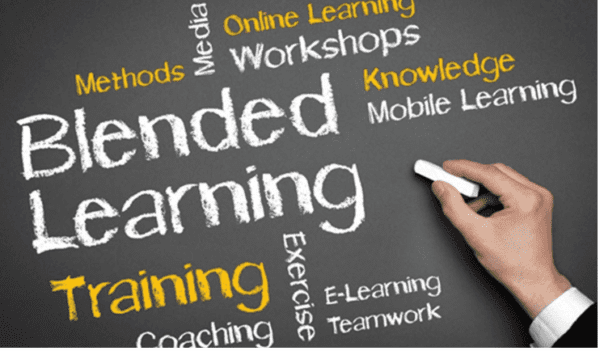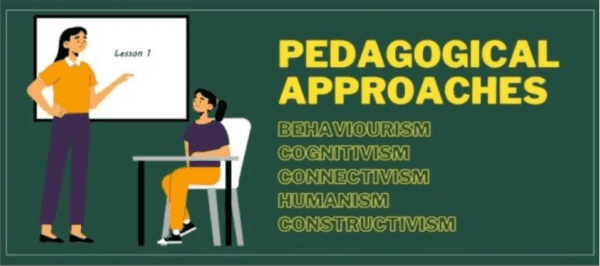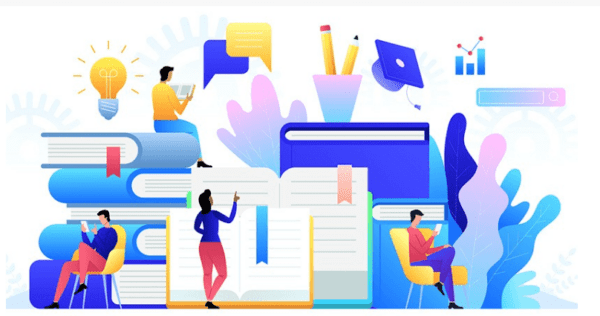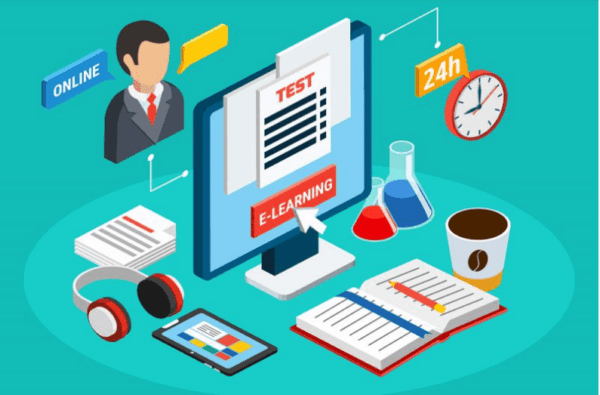Blended learning is a modern approach to education that combines online and offline learning methods. It is a flexible and practical approach that enhances student engagement, achievement, and personalization. Blended learning responds to this evolution as online and offline learning modes evolve. By combining the best of both worlds, blended learning provides a comprehensive learning experience tailored to individual learners’ needs.
Technological advances and changes in how people learn have driven the evolution of blended learning. Theoretical frameworks such as constructivism and connectivism have been vital in shaping its design and implementation. Implementation strategies for blended learning vary widely, but they all share a common goal: to create an engaging, interactive, and personalized learning environment. Despite its many benefits, blended learning also presents several challenges that must be addressed to ensure its success.

Key Takeaways
- Blended learning combines online and offline methods to provide a comprehensive learning experience.
- Theoretical frameworks like constructivism have played critical roles in shaping the design and implementation of blended learning.
- Implementation strategies for blended learning vary widely, but they all share a common goal: to create an engaging, interactive, and personalized learning environment.
Evolution of Blended Learning
Blended learning is a teaching approach that combines traditional face-to-face instruction with digital technology. It is an educational model that has evolved from formal education to digital technology. In this section, we will explore the evolution of blended learning and how it has impacted education.
From Traditional to Digital
Blended learning is a relatively new concept that has evolved from traditional education. In the past, education was delivered primarily through face-to-face instruction. However, with the advent of digital technology, education has become more accessible and convenient. Integrating digital technology into education has created new opportunities for students to learn, making education more engaging and interactive.
Blended learning combines the best of both worlds: traditional face-to-face instruction and digital technology. It allows students to learn at their own pace and provides a more personalized learning experience. Blended learning has become increasingly popular in recent years, and many educational institutions have adopted this approach to teaching.

Impact of the COVID-19 Pandemic
The COVID-19 pandemic has had a significant impact on education worldwide. The pandemic has forced many educational institutions to shift to online learning, accelerating the adoption of blended learning. The pandemic has created a “new normal” in education, where digital technology has become an essential tool for teaching and learning.
Blended learning has become a crucial component of education during the pandemic, allowing students to continue learning even when they cannot attend school in person. It has also provided teachers with new opportunities to engage with their students and made education more accessible to students who may not have had access to traditional face-to-face instruction.
Overall, blended learning has evolved from traditional education to digital technology, becoming an essential tool for teaching and learning. The COVID-19 pandemic has accelerated the adoption of blended learning, and it has become a crucial component of education in the “new normal.”
Theoretical Framework
Blended learning is a pedagogical approach that combines online and offline education to provide a more effective learning experience. The theoretical framework of blended learning includes pedagogical approaches and learning theories that support the design and implementation of blended learning courses.
Pedagogical Approaches
Pedagogy is the method of teaching and learning. Blended learning enhances the learning process using pedagogical approaches such as constructivism, collaborative learning, and critical thinking. Constructivism is a learning theory that emphasizes the importance of active learning, where learners construct their knowledge through experience and reflection. Collaborative learning is a pedagogical approach that encourages learners to work in groups to solve problems and share ideas. Critical thinking is a cognitive process that involves analyzing information, evaluating arguments, and making decisions based on evidence.

Learning Theories
Learning theories are frameworks that explain how learning occurs. Blended learning uses learning theories, such as behaviourism, cognitivism, and constructivism, to support the design and implementation of blended learning courses. Behaviorism emphasizes the role of reinforcement in learning. Cognitivism emphasizes the role of mental processes, such as attention, memory, and problem-solving, in learning. Constructivism emphasizes the importance of active learning, where learners construct their knowledge through experience and reflection.
Blended learning combines the best of online and offline education to provide a more effective learning experience. The pedagogical approaches and learning theories used in blended learning help enhance the learning process and ensure learners have the skills they need to succeed in the 21st century.
Implementation Strategies
Blended learning is a flexible and efficient way to deliver education that combines face-to-face and online learning. Here are some implementation strategies to consider when adopting blended learning:
Flipped Classroom Model
The flipped classroom model is a popular blended learning strategy. In this model, students watch online lectures and complete interactive activities before class. This allows teachers to spend more time on group projects, discussions, and problem-solving activities during class. The flipped classroom model can be implemented using a learning management system (LMS) or online platform.

Integration of Online and Offline Methods
Another critical strategy for blended learning is integrating online and offline methods. This can include online resources, such as quizzes, videos, and interactive activities, to supplement face-to-face instruction. To increase online learning, it can also involve face-to-face instruction, such as group discussions and problem-solving activities. The key is to balance online and offline methods that work best for your students and learning objectives.
Overall, blended learning is a powerful tool for delivering education that can help improve student engagement, learning outcomes, and teacher efficiency. By implementing strategies such as the flipped classroom model and integrating online and offline methods, you can create a more flexible and personalized learning experience for your students.

Challenges and Solutions
Blended learning, combining online and offline education, presents a unique set of challenges. This section will discuss some of the most significant challenges educators and students face and potential solutions.
Accessibility and Infrastructure
One of the primary challenges of blended learning is ensuring that all students have equal access to the technology and infrastructure necessary to participate fully in the course’s online components. This can be incredibly challenging for students from low-income backgrounds or those who live in rural areas with limited internet access.
To address this challenge, educators can work with their institutions to provide students with the necessary hardware and software and ensure that all students have reliable internet access. Additionally, educators can design their courses with accessibility in mind, using tools like closed captioning, screen readers, and other assistive technologies to make online content more accessible to all students.
Student Engagement and Assessment

Another significant challenge of blended learning is keeping students engaged and motivated. Online course components can be less interactive and engaging than in-person components, decreasing student motivation and participation. Additionally, assessing student learning in a blended learning environment can be challenging, as traditional assessment methods may not be well-suited to the online environment.
To address these challenges, educators can use various strategies to increase student engagement, such as gamification, interactive online activities, and group projects. Additionally, educators can use multiple assessment methods, including online quizzes, writing assignments, and peer assessments, to ensure that all students can effectively demonstrate their learning.
Overall, while blended learning presents a unique set of challenges, with careful planning and the right strategies, educators can create effective and engaging learning experiences that meet the needs of all students.
Future Trends and Research Directions
Blended learning has gained immense popularity in recent years and is expected to continue growing. As a result, researchers, policymakers, and educators are exploring the future trends and research directions of blended learning. In this section, we will discuss potential advancements in educational technology and policy and practice implications that will likely shape the future of blended learning.
Advancements in Educational Technology
One of the most significant trends in blended learning is the increasing use of educational technology. With the rapid development of technology, educators have several exciting opportunities to create innovative and engaging learning experiences for their students. For example, virtual reality (VR) and augmented reality (AR) are two technologies gaining popularity in education. VR and AR can provide students with immersive and interactive learning experiences that are impossible with traditional classroom instruction.
Another trend in educational technology is using artificial intelligence (AI) and machine learning (ML) to personalize learning experiences. AI and ML can analyze student data and provide personalized recommendations for each student. This approach can help students learn independently, improving their learning outcomes.

Policy and Practice Implications
Blended learning has several policy and practice implications that policymakers and educators must consider. One of the most significant implications is the need for professional development for educators. Educators must be trained in using educational technology and creating effective blended learning environments. Professional development can also help educators stay up-to-date with the latest trends and research in blended learning.
Another policy implication is the need for research to understand the effectiveness of blended learning better. While some research exists, more rigorous studies are needed to determine blended learning’s impact on student outcomes. Policymakers and educators must support research efforts to ensure that blended learning is evidence-based and effective.
In conclusion, blended learning is a rapidly growing field with the potential to transform education. Advances in educational technology and policy and practice implications will likely shape the future of blended learning. As a researcher, policymaker, or educator, staying up to date with the latest trends and research in blended learning is essential to ensuring that students receive the best possible education.


